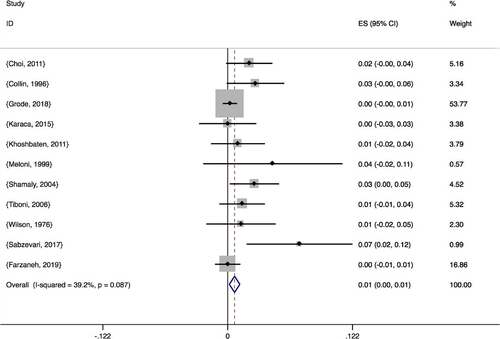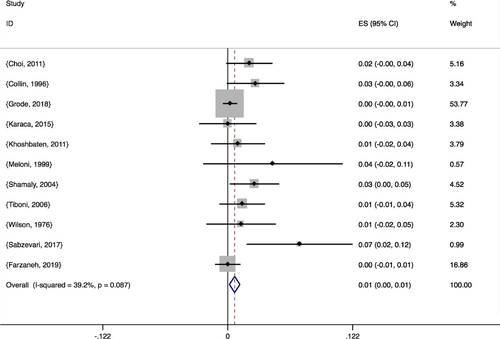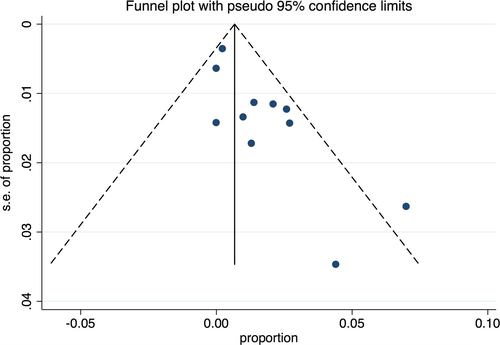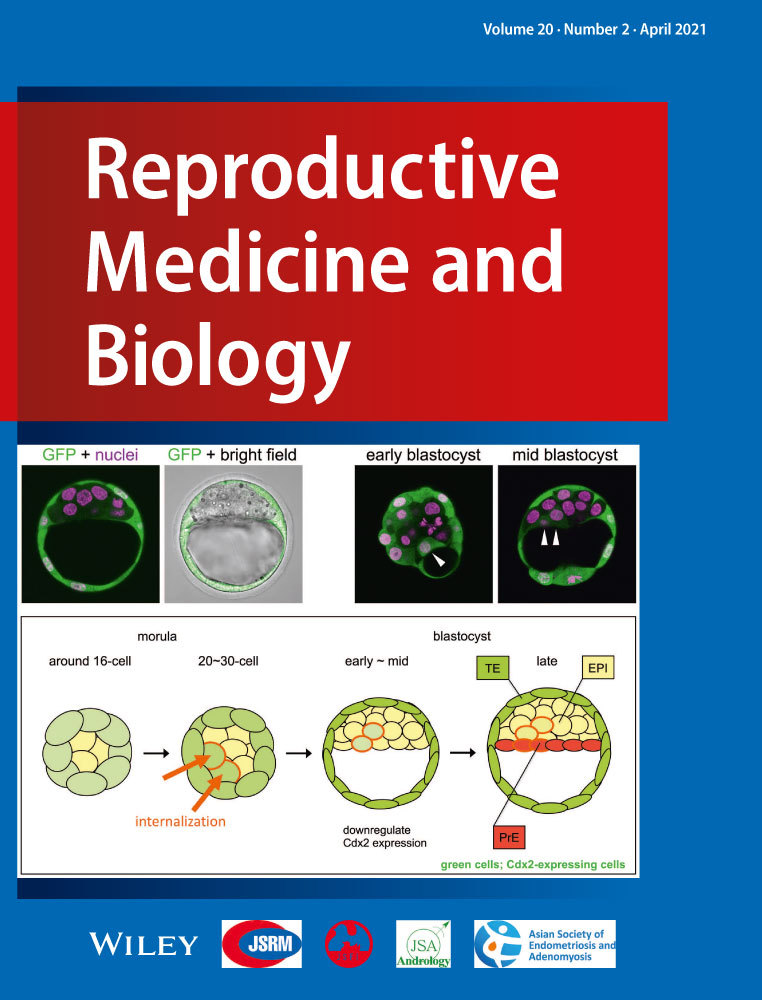The prevalence of celiac disease in women with infertility—A systematic review with meta-analysis
Abstract
Purpose
To determine the prevalence of celiac disease in infertile women.
Methods
A systematic search of four databases was conducted up until February 6, 2020. The search terms “c(o)eliac disease”, “gluten”, “vill(o)us atrophy”, “infertility” and “subfertility” yielded 1142 unique hits. Articles in other languages than English, conference abstracts, letters, and publications where relevant information was missing were excluded. In our main analysis, celiac disease had to be verified by duodenal biopsy. The titles and abstracts, and the full-text articles were independently reviewed by two researchers. A fixed-effect model was used to calculate the weighted prevalence.
Results
Based on 11 studies (1617 women), the pooled prevalence of biopsy-confirmed celiac disease was 0.7% (95% CI = 0.2%-1.2%) in women with any infertility. Restricting our study population to women with unexplained infertility, the pooled prevalence of biopsy-confirmed celiac disease was 0.6% (95% CI = 0.0%-1.6%). When including studies where celiac disease had been defined per serology (20 studies; 5158 women), the pooled prevalence of celiac disease was 1.1% (95% CI = 0.6%-1.6%) in women with any infertility.
Conclusion
Our results indicate that celiac disease is not more common in infertile women than in the general population. Celiac screening in infertile women may have low yield.
1 INTRODUCTION
Celiac disease (CD) is an immune-mediated disorder of the small intestine affecting about 1% of the general population.1 CD is more common in females than in males.2 Symptoms may include weight loss, constipation, diarrhea, abdominal pain, and bloating but also non-gastrointestinal symptoms such as psychological comorbidity and autoimmune manifestations including psoriasis.3, 4 However, some patients may show few or no symptoms at all.5
Increased prevalence of CD has been noted in several reproductive disorders, for instance, shortened fertile period, amenorrhea, hypogonadism, and recurrent pregnancy loss.6 Women with undiagnosed CD have an increased risk of preterm delivery and delivering a child with low birthweight.7 In 1970, Morris et al described three women with CD and infertility who became pregnant after adhering to a gluten-free diet8 and thereby suggesting a link between untreated CD and infertility. Since then, several studies have explored the prevalence of CD in couples or women with infertility, albeit many of them were limited by small sample sizes and yielded varying results.9-31 We32 and others33 have previously shown a normal life-time fertility in women with CD, though a decreased fertility 2 years prior to CD diagnosis cannot be ruled out.32
We are aware of two earlier meta-analyses of CD and infertility.34, 35 Both found a higher prevalence of CD in women with infertility than in the general population. A positive association was seen for both all-cause infertility and unexplained infertility. Singh et al35 reported a pooled prevalence of biopsy-proven CD in women with “all-cause” infertility of 2.3% (95% CI = 1.4%-3.5%), while Castaño et al34 reported a pooled prevalence of biopsy-proven CD in women with “overall infertility” of 1.5% (95% CI = 0.6%-2.8%).
Castaño et al34 did not require Marsh III histology for the celiac diagnosis, and both previous meta-analyses had a narrow search.34, 35 Singh et al only included five studies.35 Knowledge about the prevalence of CD in infertile women is important when defining potential risk groups for CD screening. Therefore, the objective of this study was to determine the prevalence of CD in infertile women with a wider search than the previous meta-analyses.
2 MATERIALS AND METHODS
The PRISMA guidelines36 were used to conduct this meta-analysis.
2.1 Search
The Karolinska Institutet University Library conducted a search in PubMed, Cochrane, EMBASE, and Web of Science Core Collection using the search terms “c(o)eliac disease”, “gluten”, “villous atrophy”, “infertility” and “subfertility” on February 6, 2020. A broad search strategy was used to increase sensitivity (see Appendix A for a description of the full search). The search results were reviewed by IG and LH. In case of uncertainty, JFL made the final decision. In addition to the papers identified through this PubMed search, one additional paper was identified when reviewing the search hits.31 Including this latter article,31 twenty-eight studies in total were deemed relevant for full-text review.
2.2 Eligibility criteria
We excluded the following publications: Articles in other languages than English, conference abstracts, letters, and publications where the exact number of infertile women with CD were not reported (Figure 1). In our main analysis, CD had to be verified by duodenal biopsy consistent with CD (generally Marsh III). Prevalence of biopsy-proven CD in women was calculated for both “any infertility” and “unexplained infertility.” In a second analysis, we also included studies where positive seroprevalence (at least one relevant antibody: tissue transglutaminase, endomysial, and anti-gliadin antibodies) had been used to define CD. When male infertility was identified in a couple, the woman was excluded from the analysis.

2.3 Data collection process and data items
The selected articles were reviewed systematically in detail by both IG and LH. Retrieved from each article were publication date, country of origin, age of the patients, number of infertile women, number of infertile women with CD, number of women with unexplained infertility, number of women with unexplained infertility with CD, number of controls (if any), number of controls with CD, definitions of CD and infertility, number of positive serologies, number of patients biopsied, and study design. Authors of the individual studies were not contacted.
2.4 Statistics
For the calculation of the weighted prevalence, a fixed-effect model was used. The prevalence was reported with 95% confidence intervals. The heterogeneity between studies was calculated with I2 in percentage and a P-value. A P-value < .05 was regarded as statistically significant. A meta-funnel analysis (Figure 4) was conducted to reveal potential publication bias. Statistics were calculated using STATA 13.
2.5 Ethics
This study is a meta-analysis and was therefore exempt from IRB (International Review Board) approval.
3 RESULTS
The search generated 1142 hits for review. Of these, 28 full-text articles were reviewed in detail after which eight were excluded: conference abstract (n = 4),37-40 letter (n = 1),41 infertility not defined (n = 1),28 no data on number of patients with CD (n = 1),18 and risk of overlap between study populations (n = 1).11 Hence, 20 studies were included in this meta-analysis. The selection process is illustrated in Figure 1.
3.1 Study characteristics
Out of our 20 included studies, 15 were prospective, 1 was retrospective, and 4 were cross-sectional studies. Almost half of the studies 10, 12-14, 24-26, 30, 31 had control groups. Country of origin and whether the study was consecutive are presented in Table 1. Eleven studies were included in our main analysis.9, 29, 31
| Study (year) | Country | Consecutive | Infertile women (N) | Celiac disease (N) | Percentage with celiac disease (%) | Celiac disease verified by biopsya |
|---|---|---|---|---|---|---|
| Choi, 201116 | USA | No | 188 | 4 | 2.1 | Yes |
| Collin, 199612 | Finland | Yes | 150 | 4 | 2.7 | Yes |
| Grode, 201817 | Denmark | Yes | 457 | 1 | 0.2 | Yes |
| Gunn, 201821 | Canada | No | 393 | 1 | 0.3 | No |
| Hogen Esch, 201119 | Netherlands | Yes | 1038 | 6 | 0.6 | No |
| Jackson, 200820 | USA | No | 121 | 1 | 0.8 | No |
| Juneau, 201822 | USA | Yes | 995 | 18 | 1.8 | No |
| Karaca, 201523 | Turkey | No | 65 | 0 | 0.0 | Yes |
| Khoshbaten, 201124 | Azerbaijan | No | 100 | 1 | 3.0 | Yes |
| Kolho, 199925 | Finland | No | 129 | 1 | 0.8 | No |
| Kumar, 201126 | India | Yes | 230 | 13 | 5.7 | No |
| Machado, 201327 | Brazil | Yes | 170 | 2 | 1.2 | No |
| Meloni, 19999 | Italy | Yes | 45 | 2 | 4.4 | Yes |
| Shamaly, 200414 | Israel | No | 192 | 5 | 2.6 | Yes |
| Tiboni, 200613 | Italy | Yes | 147 | 2 | 1.4 | Yes |
| Vancikova, 200230 | Czech Republic | No | 363 | 4 | 1.1 | No |
| Wilson, 197615 | UK | No | 77 | 1 | 1.3 | Yes |
| Sabzevari, 201729 | Iran | No | 100 | 7 | 7.0 | Yes |
| Farzaneh, 201931 | Iran | No | 150 | 0 | 0.0 | Yes |
| Fasano, 200310 | USA | No | 48 | 3 | 6.3 | No |
Note
- Study named with first author and year of publication.
- a For biopsy verification, we required that all individuals with suspected celiac disease underwent small intestinal biopsy and had Marsh III (see text). The 11 studies verified by biopsy (“yes”) constituted the basis for our main analysis.
Very few studies followed up their patients. Only Collin et al12 had followed up with new biopsies 6-12 months after the first one. Two studies15, 27 mentioned having a follow-up but did not specify details. Farzaneh et al31 noted that both women they considered as having CD started on a gluten-free diet. These women were not included in our analysis for biopsy-proven CD since they did not have a biopsy with Marsh III histology.
The definitions of infertility varied between studies. Only four studies16, 21, 27, 29 specifically mentioned a definition similar to the WHO equal to “failure to achieve a clinical pregnancy after 12 months or more of regular unprotected sexual intercourse”.42 For participants in the study by Sabzevari et al,29 women aged > 35 years only required infertility for more than 6 months. Several studies referred to their population as women visiting a hospital because of infertility.12-15, 17, 19, 22, 25, 31 Moreover, unexplained infertility was mostly defined when not finding a reason for infertility9, 12, 20, 23, 24, 26, 29, 30 or simply stating it as unexplained.10, 17 In some cases, authors specified conducting a series of tests such as blood tests (LH, FSH, prolactin), ultrasound, semen analysis, and sometimes diagnostic laparoscopy and endometrial biopsy.9, 12, 23, 24, 26, 30
3.2 Prevalence of biopsy-verified CD in infertile women
We identified 11 studies9, 29, 31 with 1617 women undergoing screening for CD and where all women with a positive serology were followed up by duodenal/jejunal biopsy (Figure 2). In these women, 27 had a biopsy-confirmed CD (1.7%). Weighting the prevalence using a fixed-effect model, the pooled prevalence of CD was 0.7% (95% CI = 0.2%-1.2%). The heterogeneity was 39.2% (P = .087) indicating only a moderate heterogeneity, and for that reason (heterogeneity P > .05), we abstained from subgroup analyses. Removing the large Danish study by Grode et al,17 which dominated the analysis, the pooled prevalence was 1.2% (95% CI = 0.4%-2.0%).

When investigating only women with unexplained infertility, the pooled prevalence of biopsy-verified CD was 0.6% (95% CI = 0.0%-1.6%) based on nine studies9, 12-14, 16, 23, 24, 29, 31 with a total of 834 patients. The heterogeneity was 17.1% (P = .295).
3.3 Prevalence of positive CD serology in infertile women
We identified 20 studies9, 10, 29-31 with a total of 5158 women undergoing serological screening for CD but where only a subset of individuals underwent biopsy (Figure 3). The pooled prevalence of CD defined per serology (positive TTG, EMA, or gliadin antibodies) was 1.1% (95% CI = 0.6%-1.6%) (heterogeneity: P < .006; I2 = 49.7%). In this analysis, the largest included study was that by Hogen-Esch et al,19 where 6/1038 (0.6%) infertile women were serologically positive for CD.

3.4 Risk of bias across studies
A meta-funnel analysis (Figure 4) revealed potential publication bias, since it seemed that small studies with a high prevalence of CD were more likely to be published than small studies with a low infertility prevalence.

4 DISCUSSION
In this meta-analysis, we observed that, when using a strict definition of CD (confirmation through biopsy and requiring Marsh III), CD is not more common in women with infertility than the general population. These findings differ from two previous meta-analyses,34, 35 which both observed a higher CD prevalence in both women with all-cause and unexplained infertility. For biopsy-proven CD, Castaño et al34 found a pooled prevalence of 1.5% (95% CI = 0.6%-2.8%), while Singh et al35 reported a pooled prevalence of 2.3% (95% CI = 1.4%-3.5%). One of the reasons for this difference in results might be the definition of CD. Some studies have considered Marsh I to be sufficient for CD diagnosis, while others have not used the Marsh criteria at all but merely reported that CD was confirmed with biopsy. Castaño et al34 based their meta-analysis on reported numbers of patients with CD confirmed with biopsy, but did not specify if Marsh III was required. These different criteria for CD may account for the inconsistent findings.
The current and previous34, 35 meta-analyses differ in the studies included. The meta-analysis by Singh et al35 only included five articles. Our search was wider (we considered more databases and included more search terms) and yielded more titles and abstracts to review than both the two earlier meta-analyses combined.34, 35 Despite our wider search, much the same papers were included in our meta-analysis and that of Castaño et al34 after applying our exclusion criteria. We included 11 articles9, 29, 31 in the main analysis with biopsy-proven CD, while Castaño et al34 included six articles.12-14, 16, 17, 27 Castaño et al34 limited their analysis to articles with >100 infertile women. In contrast to Castaño et al,34 we did not include Machado et al27 in our final analyses as the latter study did not confirm all serology-positive cases with biopsy. For the analysis concerning serology-verified CD, our meta-analysis included 20 articles with the only additional article to Castaño et al34 being Farzaneh et al31 With this in mind, there are differences in how the data have been interpreted. Furthermore, we excluded all women whose infertility was explainable at least in part by male infertility since male infertility may incorrectly lead to a misclassification of actual fertility in the woman. These women were included in the Singh et al and Castaño et al studies.34, 35
A concern when selecting articles for our meta-analysis was the different definitions of infertility used in individual papers. Only some studies16, 21, 27, 29 specifically stated that they had used the WHO definition42 or a close version of it. This may have resulted in a different patient selection in meta-analyses. For example, it is unclear whether patients with recurrent spontaneous abortions were included as a reason for infertility. If recurrent spontaneous abortion was treated as a separate condition in the original article, those patients were not included in our analyses. Same-sex couples may also visit an infertility clinic although several studies13-17, 19, 22, 25, 31 have described excluding these patients.
Some of the studies included in our paper10, 19-22, 25-27, 30 have only based their CD diagnosis on positive serological markers. This results in a higher proportion of positive CD cases. IgA-TTG, the most commonly used antibody for screening of CD, has a high sensitivity and specificity (both 90.9%) but may still have a low positive predictive value43 which is why we chose to calculate CD seroprevalence in infertility separately. Our results are in line with the previous studies on serological screening for CD.43
It has been suggested that CD would be more common in unexplained infertility than in any (all-cause) infertility. If no cause is identified, the reason might be an unrecognized underlying disease such as CD. It is known that CD causes inflammation, malabsorption, and extraintestinal manifestations.5 Schiepatti et al6 suggest that women with CD more often have a shortened fertile period, amenorrhea, and hypogonadism. All these factors might potentially increase the risk of infertility in CD. Malabsorption-induced nutrient deficit of, for example, zinc, selenium, and folic acid might be another reason for adverse gynecologic and obstetric manifestation.44 Finally, there may be autoimmune components in CD contributing to infertility. One such mechanism could be an inhibiting effect of anti-transglutaminase antibodies on endometrial angiogenesis.44 In some individual studies in our meta-analysis, the prevalence of CD was much higher when considering only unexplained infertility,12, 16, 26, 27 although all of them had small sample sizes. In our analysis, we could not confirm a connection between unexplained infertility and CD, and the prevalence of CD in unexplained infertility was very similar to that in any infertility.
Infertility may be due to a number of conditions including polycystic ovarian syndrome, endometriosis, and hypo- or hyperthyroidism, but also amenorrhea, weight loss, and malnutrition all of which are overrepresented in CD.44, 45 However, our main analysis did not reveal any association with infertility and hence none of the above factors were explored.
Our paper has some strengths and limitations. We excluded non-English papers since we were unable to extract complete data from such studies. In our meta-funnel analysis (Figure 4), we found a potential publication bias where small studies with a high CD prevalence were more likely to be published. Had a larger number of smaller studies with low CD prevalence been published, that would have driven the prevalence estimates down even further. We followed the PRISMA guidelines when carrying out our study. Two researchers independently of each other carried out the review of titles, abstracts, and full-text articles, thus ensuring objectiveness and a more accurate result.
Many previous studies have found a prevalence of CD of about 1% in the general population.2 In the systematic review and meta-analysis by Singh et al,2 a seroprevalence of 1.4% and a prevalence of biopsy-proven CD of 0.7% were found when analyzing articles screening general populations in all continents. The CD prevalence is possibly even higher in women since many autoimmune diseases, including CD, have been linked to female sex.46-49 Our finding of a seroprevalence of 1.1% and a prevalence of biopsy-proven CD of 0.7% indicates that CD is not more common in women with infertility. A study by Dhalwani et al50 further supports this claim. They examined potentially fertile women with CD and without CD in UK primary care to compare the rate of infertility and noted no increase in infertility in women with CD, except in a subset of women aged 25 to 29 years. We acknowledge the lack of fertile female controls as a limitation of our study.
Noteworthy is the low number of participants in most studies. Only 1 out of the 11 studies in our main analysis, and 6 out of the 20 studies in the analysis of seroprevalence of CD, had more than 200 participants (Table 1). Future studies should focus on examining larger well-defined populations of women with infertility and a control group to explore whether there is a connection between CD and infertility.
Knowledge of the prevalence of CD in women with infertility is important for screening decisions. In this meta-analysis, 0.7% of women with infertility had biopsy-verified CD. This indicates that CD is not more common in infertile women than in the general population.
ACKNOWLEDGEMENTS
Karolinska Institutet University Library for conducting the database search.
DISCLOSURES
Conflict of interest: The authors Ida Glimberg, Linnea Haggård, Benjamin Lebwohl, and Peter Green declare no conflicts of interest. Jonas F Ludvigsson coordinates a study on behalf of the Swedish IBD quality register (SWIBREG). This study has received funding from Janssen Corporation. Human /Animal rights: This article does not contain any studies with human and animal subjects performed by the any of the authors.
ETHICAL APPROVAL
Approval from Ethics Committee was not required.
APPENDIX A
1. MEDLINE
|
Interface: Ovid MEDLINE(R) and Epub Ahead of Print, In-Process & Other Non-Indexed Citations and Daily Date of Search: 2020-02-06 Number of hits: 599 Comment: In Ovid, two or more words are automatically searched as phrases; ie no quotation marks are needed |
Field labels
|
|
1. Celiac disease/ 2. exp Glutens/ 3. exp Transglutaminases/ 4. (celiac* or celiak* or coeliac* or coeliak* or non-tropical sprue or nontropical sprue).ti,ab,kf 5. (gluten* or gliadin*).ti,ab,kf 6. (endomys* OR antiendomys* OR ema OR aea OR transglutamin* OR anti-transglutamin* OR trans glutamin* OR ttg OR tta).ti,ab,kf 7. ((villus OR villous) ADJ3 atroph*).ti,ab,kf 8. 1 OR 2 OR 3 OR 4 OR 5 OR 6 OR 7 9. exp Infertility/ 10. exp Fertility/ 11. exp Fertilization in Vitro/ 12. (fertil* OR infertil* OR subfertil* OR sub-fertil* OR steril*).ti,ab,kf 13. ((in-vitro OR in vitro) ADJ3 fertil*).ti,ab,kf 14. 9 OR 10 OR 11 OR 12 OR 13 15. 8 AND 14 |
|
2. EMBASE
|
Interface: embase.com Date of Search: 2020-02-06 Number of hits: 1062 Comment: Emtree is the controlled vocabulary in Embase |
Field labels
|
|
1. 'celiac disease'/de 2. ’gluten’/de 3. ’gliadin’/de 4. 'protein glutamine gamma glutamyltransferase'/de 5. 'protein glutamine gamma glutamyltransferase 2'/de 6. 'endomysium antibody'/de 7. ’endomysium’/de 8. (celiac* OR celiak* OR coeliac* OR coeliak* OR 'non-tropical sprue' OR 'nontropical sprue'):ti,ab,kw 9. gluten*:ti,ab,kw OR gliadin*:ti,ab,kw 10. (endomys* OR antiendomys* OR ema OR aea OR transglutamin* OR 'anti transglutamin*' OR ‘trans glutamin*’ OR ttg OR tga):ti,ab,kw 11. ((villus OR villous) NEAR/3 atroph*):ti,ab,kw 12.1 OR 2 OR 3 OR 4 OR 5 OR 6 OR 7 OR 8 OR 9 OR 10 OR 11 13. ‘infertility’/exp 14. ‘fertility’/exp 15. ‘in vitro fertilization’/exp 16. (fertil* OR infertil* OR subfertil* OR sub-fertil* OR steril*):ti,ab,kw 17. ((‘in vitro’) NEAR/3 fertil*):ti,ab,kw 18. 13 OR 14 OR 15 OR 16 OR 17 19. 12 AND 18 |
|
3. COCHRANE LIBRARY
|
Interface: Wiley Date of Search: 2020-02-06 Number of hits: 41 |
Field labels
|
|
1. (celiac* OR celiak* OR coeliac* OR coeliak* OR 'non-tropical sprue' OR 'nontropical sprue'):ab,ti,kw 2. (gluten* OR gliadin*):ab,ti,kw 3. (endomys* OR antiendomys* OR ema OR aea OR transglutamin* OR 'anti transglutamin*' OR ‘trans glutamin*’ OR ttg OR tga):ti,ab,kw 4. ((villus OR villous) NEAR/3 atroph*):ti,ab,kw 5. 1 OR 2 OR 3 OR 4 6. (fertil* OR infertil* OR subfertil* OR sub-fertil* OR steril*):ti,ab,kw 7. (‘in vitro’) NEAR/3 fertil*):ti,ab,kw 8. 6 OR 7 9. 5 AND 8 |
|
4. WEB OF SCIENCE CORE COLLECTION
|
Interface: Clarivate Analytics Date of Search: 2020-02-06 Number of hits: 1277 |
Field labels
Note: sometimes “quotation marks” are needed for single search terms to avoid automatic term mapping (lemmatization). |
|
1. TOPIC: (celiac* OR celiak* OR coeliac* OR coeliak* OR 'non-tropical sprue' OR 'nontropical sprue') 2. TOPIC: (gluten* OR gliadin*) 3. TOPIC: (endomys* OR antiendomys* OR ema OR aea OR transglutamin* OR 'anti transglutamin*' OR ‘trans glutamin*’ OR ttg OR tga) 4. TOPIC: (((villus OR villous) NEAR/3 atroph*)) 5. 1 OR 2 OR 3 OR 4 6. TOPIC: (fertil* OR infertil* OR subfertil* OR sub-fertil* OR steril*) 7. TOPIC: (‘in vitro’ NEAR/3 fertil* 8. 6 OR 7 9. 5 AND 8 |
|




